Lindsay Bernard Hall stands as a significant, if sometimes overlooked, figure in the art world bridging Great Britain and Australia at the turn of the 20th century. An accomplished painter in his own right, his most profound and lasting impact was arguably made during his long tenure as the Director of the National Gallery of Victoria (NGV) in Melbourne and as the influential head of its associated art school. His career reflects the academic traditions of late 19th-century European art, a dedication to craftsmanship, and a pivotal role in shaping Australian artistic taste and education for over four decades.
Early Life and Artistic Formation
Born on December 28, 1859, in Garston, Liverpool, England (not Chedle, Staffordshire, as sometimes mistakenly cited), Lindsay Bernard Hall was the son of a literary-minded father, also named Lindsay Hall, who was a writer and a founder of the Liverpool Arundel Society. This familial environment likely fostered an early appreciation for culture and the arts. His formal art education was comprehensive and aligned with the rigorous academic standards of the era.
Hall commenced his studies at the South Kensington School of Art (now the Royal College of Art) in London, a crucible for many aspiring artists. He then sought further refinement on the continent, a common practice for ambitious British artists of his generation. He studied in Antwerp under Charles Verlat, a prominent Belgian painter known for his historical scenes and animal subjects, and later in Munich under Ludwig von Löfftz, a respected figure in the Munich School, known for its dark palette and emphasis on realism. These experiences imbued Hall with a strong foundation in draughtsmanship, anatomy, and the classical principles of composition. His training emphasized meticulous observation and technical proficiency, hallmarks that would define his own artistic output and his pedagogical approach.
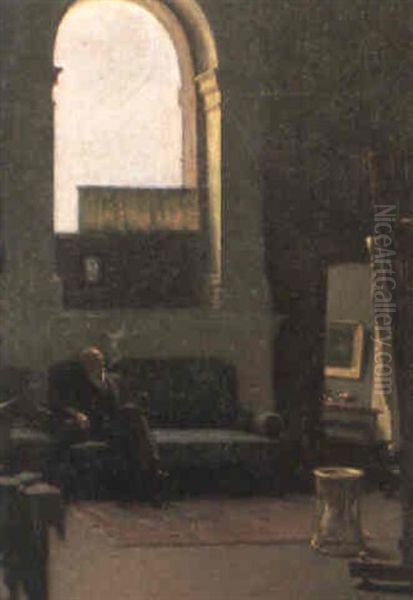
Upon returning to London, Hall began to establish himself as a painter. He exhibited at prestigious venues such as the Royal Academy of Arts and the Society of British Artists (later the Royal Society of British Artists). During this period, he would have been aware of, and interacting with, the vibrant and diverse London art scene, which included towering figures like Lord Frederic Leighton, Sir Lawrence Alma-Tadema, and Sir Edward Poynter, all exemplars of the classical academic tradition. Simultaneously, new artistic currents were emerging with artists like James McNeill Whistler, whose tonalism and aesthetic sensibilities were gaining traction, and the burgeoning New English Art Club, which championed more impressionistic and plein-air approaches, featuring artists such as Philip Wilson Steer and Walter Sickert.
A New Chapter in Australia: Directorship of the National Gallery of Victoria
The pivotal moment in Hall's career came in 1891. Following the death of George Frederick Folingsby, the Director of the National Gallery of Victoria and Master of its School of Art, a search was initiated for a successor. Hall, then in his early thirties, applied for the position. His application was successful, and he arrived in Melbourne in March 1892 to take up his dual responsibilities. This appointment would define the remainder of his professional life, spanning an impressive 43 years until his death.
His arrival in Australia placed him at the heart of a burgeoning, yet still developing, art scene. The Heidelberg School, with key figures like Tom Roberts, Arthur Streeton, Charles Conder, and Frederick McCubbin, had recently made its mark with its distinctively Australian impressionistic landscapes. While Hall's own artistic inclinations were more conservative and rooted in European academicism, his role as Director and teacher meant he would inevitably interact with and influence generations of Australian artists, including some who embraced more modern styles.
As Director of the NGV, Hall was instrumental in building its collection, particularly through his judicious advice on acquisitions made possible by the significant Felton Bequest, established in 1904. This bequest provided substantial funds for purchasing artworks, and Hall, as the Gallery's chief advisor in London for many years, played a crucial role in selecting pieces that would enrich Australia's premier art institution. His choices often reflected his academic tastes, favoring established European masters and contemporary British academic painters, though he also acquired works that were, for their time, quite forward-looking.
Artistic Style and Thematic Concerns
Lindsay Bernard Hall was a versatile artist, though he is perhaps best known for his refined and sensitive depictions of the nude, interior scenes, portraits, and still lifes. His style was characterized by its academic precision, subtle tonal harmonies, and an emphasis on capturing the play of light and texture. While he was aware of Impressionism and Post-Impressionism, his own work remained largely within the bounds of representational art, valuing careful drawing and a polished finish.
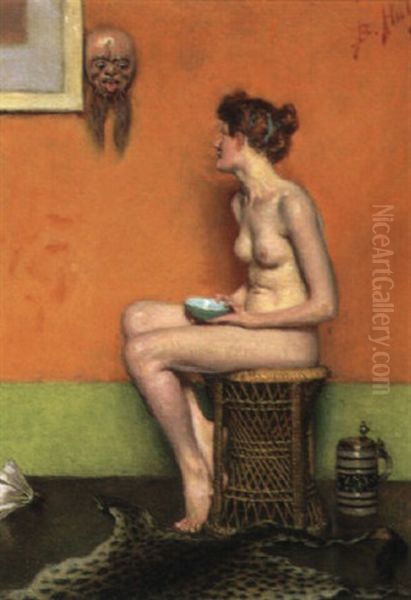
His nudes, often set in dimly lit interiors, are notable for their classical elegance and quiet introspection. Works like "Sleep" and "The Nude" (sometimes titled "Reclining Nude") showcase his mastery of anatomy and his ability to render flesh tones with a delicate luminosity. These paintings often evoke a sense of intimacy and contemplation, avoiding overt sensuality in favor of a more aesthetic appreciation of the human form.
Interior scenes were another significant genre for Hall. These paintings often feature solitary figures, usually women, engaged in quiet domestic activities or moments of reflection. Titles such as "My Home," "After Dinner," "Interior," and "The Glass Bottle" (likely a still life or an interior with a prominent glass object) suggest a focus on the intimate spaces of daily life. His work "The Studio" (c. 1918) is a particularly fine example, depicting an artist, possibly a self-portrait or a representation of the artistic environment, surrounded by the accoutrements of his profession. These interiors are often characterized by their careful arrangement of objects, subtle lighting, and a palpable sense of atmosphere.
Hall was also an accomplished portraitist. He painted numerous portraits throughout his career, including commissions and more personal studies. His portraits are generally characterized by their psychological insight and technical skill, capturing a likeness while also conveying something of the sitter's personality. His "Self Portrait" (1919) in the NGV collection is a strong example of his capabilities in this genre.
The provided list of works – "My Home" , "After Dinner" , "The Model" , "Shyness" , "The Glass Bottle" , "Interior" , "Coquetry" , and "Despair" – accurately reflects his thematic interests in genre scenes, psychological states, and still life elements. "Coquetry" and "Shyness," for instance, point towards an interest in capturing nuanced human emotions and interactions, often within an interior setting. "Despair" suggests a more dramatic or allegorical subject, showcasing his capacity for conveying strong emotional content.
It is important to clarify that while Hall painted landscapes, he was not primarily known for "depicting Australian wildlife and landscapes" in the manner of a dedicated wildlife illustrator like Neville Cayley or John Gould, nor was he a key figure in the Australian landscape tradition in the same vein as the Heidelberg School painters. His primary strengths lay in figure painting, portraiture, and interiors.
The NGV Art School and Pedagogical Influence
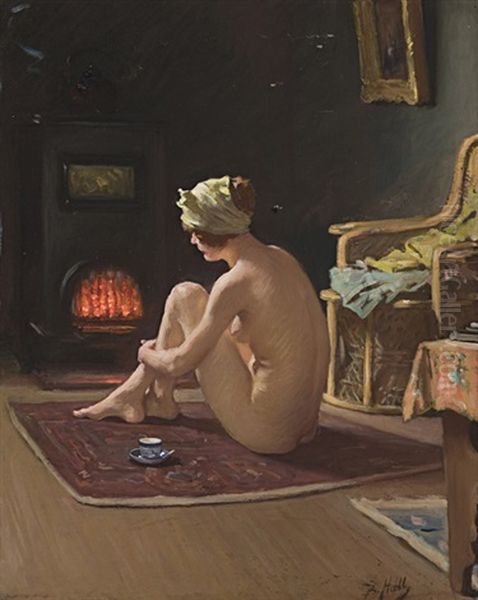
Beyond his role as Gallery Director, Hall's position as Master of the NGV Art School was profoundly influential. For over four decades, he oversaw the training of countless Australian artists. His teaching methods were rooted in the academic tradition he himself had experienced, emphasizing rigorous training in drawing from the antique and the live model. He instilled in his students a respect for craftsmanship and a thorough understanding of artistic fundamentals.
Many prominent Australian artists passed through the NGV School during his tenure. These included figures such as Max Meldrum, who would later develop his own distinct theory of tonal realism and become a somewhat controversial figure and a rival teacher. Other notable students included Hugh Ramsay, a prodigious talent whose promising career was cut short by illness, George Bell, who would later become a significant proponent of modern art in Australia, and William (Jock) Frater, another artist who would embrace Post-Impressionist ideas. The list also includes artists like Clarice Beckett, known for her ethereal tonal landscapes, and Margaret Preston, who, while developing a very different modernist style, would have received her foundational training there.
Hall's teaching, while traditional, provided a solid technical grounding that students could then build upon, whether they chose to follow academic paths or explore more modernist avenues. His long stewardship of the school ensured a continuity of classical training in Australia for a significant period. He was known to be a demanding but fair teacher, respected for his knowledge and dedication.
Exhibitions, Publications, and Broader Context
Throughout his career in Australia, Hall continued to paint and exhibit his work. He was a regular exhibitor with the Victorian Artists' Society and other art societies in Australia. While specific details of every exhibition for each listed work like "My Home" or "After Dinner" are not readily available without extensive archival research, it is certain that his major pieces would have been shown in these prominent local exhibitions. His works were acquired by the NGV and other Australian public collections, cementing his place as a significant artist in his adopted country.
Beyond his painting, Hall was also a man of letters, publishing several volumes of poetry, including "Poems" (1897) and "Sleep, or The Similitude of Anodos" (1910). This literary inclination perhaps informed the often poetic and contemplative mood of his paintings.
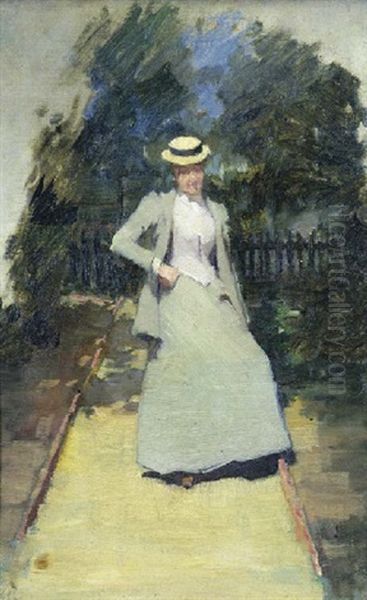
It's important to note that the anecdotes mentioned in the initial prompt concerning a "Bernard Hall" serving as a North Toxteth councillor or establishing a "Florence Institute" in memory of a daughter do not pertain to Lindsay Bernard Hall, the artist and NGV Director. These appear to relate to a different individual, possibly Bernard Hall, a Liverpool merchant and politician. Lindsay Bernard Hall's life was centered around his artistic practice and his duties at the National Gallery of Victoria in Melbourne.
His directorship coincided with major shifts in the global art world, from the twilight of Victorian academicism through the rise of Impressionism, Post-Impressionism, Fauvism, Cubism, and Surrealism. While Hall himself remained an adherent of more traditional aesthetics, his position required him to be aware of these developments, particularly in his role advising on acquisitions for the NGV. His purchasing decisions, especially through the Felton Bequest, sometimes sparked debate, as is often the case with public art procurement, but they undeniably shaped the NGV's collection into one of international standing. He was, for instance, instrumental in acquiring works by artists like Camille Pissarro and Puvis de Chavannes for the gallery.
Later Years and Enduring Legacy
Lindsay Bernard Hall remained Director of the National Gallery of Victoria and Head of its Art School until his death. He passed away in London on February 14, 1935, while on a purchasing trip for the Felton Bequest. His death marked the end of an era for the NGV and for art education in Victoria.
His legacy is multifaceted. As an artist, he produced a body of work characterized by technical skill, refined aesthetics, and a sensitive portrayal of his subjects. His nudes and interiors, in particular, hold an important place in the history of Australian academic art. As a Gallery Director, he oversaw a period of significant growth and development for the NGV, transforming its collection through astute, if sometimes conservative, acquisitions. His long tenure provided stability and a consistent vision for the institution.
Perhaps his most enduring legacy lies in his role as an educator. For over forty years, he shaped generations of Australian artists, providing them with a rigorous academic foundation. While some of his students would go on to embrace artistic styles far removed from his own, the discipline and technical proficiency he instilled remained a valuable asset. He was a link to the European academic tradition, transplanted to Australian soil, and his influence, both direct and indirect, was felt for many years.
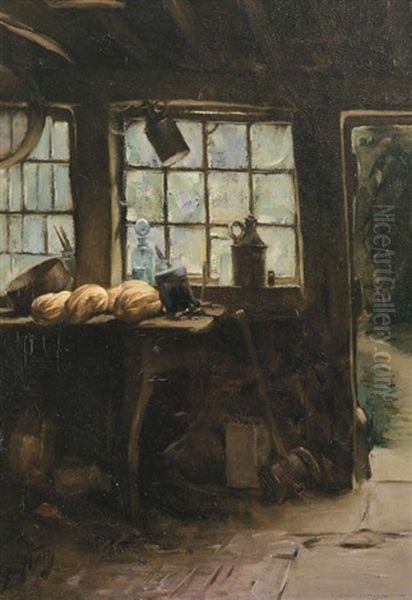
In the broader context of art history, Lindsay Bernard Hall can be seen as a figure who upheld the values of academic art in an age of increasing modernism. While not an avant-garde innovator, his dedication to craftsmanship, his skill as a painter, and his profound impact on a major cultural institution and its school secure his position as a key contributor to the artistic landscape of Australia. His contemporaries in Britain included not only the established academicians but also figures like John Singer Sargent, whose bravura brushwork offered a different kind of modern appeal, and in Australia, he worked alongside and taught artists who would define Australian art in the 20th century. His career is a testament to the enduring power of classical training and the significant role that dedicated individuals can play in shaping the cultural life of a nation.